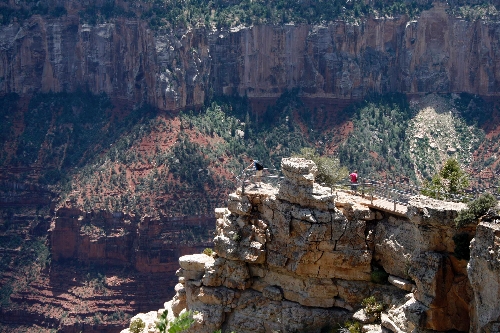DEBORAH WALL: Grand Canyon’s North Rim a step above

If a visit to the Grand Canyon National Park is on your summer schedule, I recommend heading to the canyon’s North Rim rather than the better-known and thus more crowded South Rim. The North Rim affords classic views just as stunning as those visible from the South Rim but you get to enjoy them in cooler weather. Summer daytime high temperatures on the North Rim average in the 70s. And nighttime lows drop to the 40s, making good sleeping weather for campers.
The North Rim also receives twice the amount of precipitation, which results in great wildflower displays and an abundance of lush vegetation. This area supports aspen groves, white fir, ponderosa pine, Englemann spruce and blue spruce. You also will find sweeping grassy meadows and small ponds, perfect places to view wildlife.
Three weeks ago when I visited, I saw dozens of deer, and I also got to see the resident herd of bison grazing in the open meadow just after the park’s main entrance. These nonnative bison were introduced to this area in the early 1900s in an attempt to produce cattalo, a hybrid bison-cattle. The privately owned venture was unsuccessful, so the herd is now managed by the Arizona Game and Fish Department.
While many hikers come to the North Rim to venture down into the canyon and the Colorado River, there are many trails near or along the rim that are well worth your time. For the best views into the canyon along an easy trail, the half-mile round-trip Bright Angel Point Trail is a good choice. The paved trail starts near the back porch of the Grand Canyon Lodge.
For a greater challenge with more diversity, the Widforss Trail is a good choice. This trail is about 10 miles round trip, but the elevation changes only 650 feet in that distance. Not only does the trail have classic canyon views, but you’ll be able to see crinoid fossils and travel through groves of ponderosa and aspen. This is a good trail for viewing wildlife. You might see deer, bobcats, wild turkeys or even a Kaibab squirrel, which is native only to the Kaibab Plateau on the north side of the Colorado River. You can recognize it by its tufted ears and its signature bushy white tail.
The only developed public campground in this area of the park is North Rim Campground. Campsites start at $18, and reservations are almost always needed; make them through recreation.gov or by calling 877-444-6777. Once in a while, they have openings for walk-ins, but I wouldn’t count on it.
Dispersed camping is the way to go for a guaranteed site and more solitude, which, in my opinion, equals more fun. You can do it just outside of the park’s boundary on Kaibab National Forest land. There are hundreds of choices along the gravel roads in the area. The U.S. Forest Service asks that you use a spot where someone has camped previously, at least one-quarter mile away from a water source, 200 feet from a main road and 20 feet from the forest roads.
For more information on dispersed camping, stop at the Kaibab Plateau Visitor Center in Jacob Lake on your way to the park or inquire at the North Rim Visitor Center. The staff at either place can tell you about the camping rules, give you up-to-date weather information and let you know if there are any current fire restrictions. Both centers have great selections of area maps.
The North Rim’s visitor services, lodging and restaurants are open from mid-May to mid-October.
Deborah Wall is the author of “Great Hikes, A Cerca Country Guide” and “Base Camp Las Vegas: Hiking the Southwestern States,” published by Stephens Press. She can be reached at deborabus@aol.com.
DirectionsFrom Las Vegas, take Interstate 15 north about 125 miles to Utah Route 9, the Hurricane/Zion National Park exit. Drive about 12 miles and turn right onto Utah Route 59 east. This turns into Arizona Route 389 at the state border. Drive about 53 miles to Fredonia and turn right onto U.S. Highway 89 Alt. for about 30 miles. Turn right at Jacob Lake onto Arizona Route 67, the Grand Canyon Highway. Continue for about 45 miles to the Grand Canyon, North Rim Visitor Center and Lodge.












